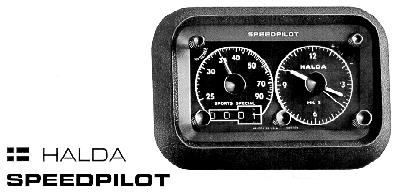|
Instructions for using the Speedpilot Mk. V
from catalog of Halda instruments distributed by Burns Industries of Buffalo, NY

What is it?
The Halda Speedpilot MK V is a fine precision instrument which computes time and distance in relation to a pre-selected average speed requirement.
What does it do?
The Halda Speedpilot MK V takes known factors; i.e., average speed desired, actual distance traveled and actual time taken, and computes your time in relation to true time.
How does it do it?
The Halda Speedpilot MK V obtains an accurate distance measure from your speedometer cable. The average speed selection knob controls a series of variations which determine the progress of the pilot hand. It is the progress of the pilot hand which continuously indicates any variation from true time.
What comes in a Speedpilot Kit?
1 Halda Speedpilot MK V Instrument
1 Halda Speedpilot Mounting Bracket
1 Halda 8:1 Reduction T-Gear to fit your specific speedometer
2 Halda Cable Clips
1 Halda 18" long cable
1 Halda Installation, Calibration & Operation Instruction Sheet
1 Halda Guarantee Card
How is it installed?
The mounting bracket is installed beneath the dashboard, and the Speedpilot is fitted to the bracket provided. The speedometer cable is detached from the speedometer and the T-Gear mounted directly behind the speedometer. The speedometer cable is then connected to the T-Gear. The Halda drive cable is then fitted to the T-Gear and the Speedpilot and retained in position with the clips provided. A wire is then connected from the instrument light circuit of the car to the Speedpilot illuminating terminal on the back of the instrument.
How is it calibrated?
The car is run over a known distance, five miles is recommended, then the reading from the Speedpilot odometer is noted. Simple math will determine how many hundredths of a mile the instrument is "off" per mile. A single calibration screw, which is located on the underside of the Speedpilot, is turned 360º for each 1/100th of a mile of error. Re-running of the measured distance will permit a small final adjustment to insure accurate calibration.
The clock can be adjusted in the normal way through the adjusting screw on the back of the Speedpilot.
What do all the knobs do?
- Upper Left. This turns the instrument on and off; also selects either 1:1 or 1/2:1 scale which permits average speed down to 12 1/2 M.P.H.
- Upper Right. This adjustment permits the Speedpilot to be matched to the "Rallymasters Mile" at the odometer check. Up to a 15% discrepancy can be accommodated.
- Lower Left. This knob "zeros" the odometer. When pulled out and turned, mileage can be added and when mileage is added, this untraveled mileage is reflected on the pilot hand.
- Lower Centre. This knob selects the average speed which is desired. When pulled out, it permits setting of the pilot hand on the clock. The pilot hand may be adjusted both forward and backwards.
- Lower Right. This winds the clock, and when pulled out, adjustment of the clock time can be made.
How is it used?
At the start of the rally, zero the odometer, adjust the clock to match the Rallymaster watch. Set the pilot hand to your out-time. As you leave the start, select the average speed and turn on the Speedpilot. Driving at the prescribed speeds, you should keep the pilot hand hidden behind the minute hand of the clock. At the odometer check, figure what percentage of error the Speedpilot shows in relation to the Rallymaster and adjust the UPPER RIGHT knob to compensate. From this point on, your Speedpilot is matched to the Rallymaster. The Speedpilot will now give you a continuous reading of your time in relation to true time. If you go too fast, the pilot hand will be ahead of the minute hand; if too slow, the pilot hand will fall behind. As you encounter a speed change, you carefully adjust the average speed indicator, and slow down or speed up as required - any error in your time is automatically carried over and by adjusting your speed, the error can be eliminated.
What do you do if you go OFF COURSE?
Immediately you realize your error and turn around, switch off the Speedpilot and take a note of your Speedometer's mileage, drive at any safe speed back to the official course, check your speedometer to establish your Off-course mileage. Then continue on course for the same distance before turning the Speedpilot on again. Any speed changes encountered while making up this mileage should be adjusted in the normal way on the Speedpilot.
The Speedpilot will now show the correct distance recording and automatically indicate how much time you have to make up to compensate for the detour.
|